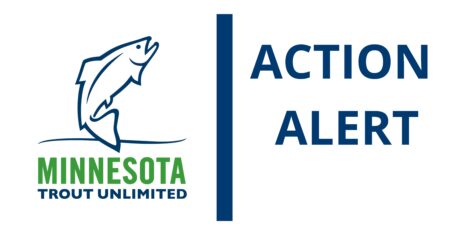Some major issues affecting sustained health of Minnesota’s coldwater fisheries
January 2023
Public Access – Permanent DNR easements along streams ensure fishing access, the ability to restore habitat, and protection of riparian corridors. Loss of “informal” access is accelerating. Substantially increased funding is needed now to seize generational opportunities before lands are sold and subdivided, or posted. Better signage and policy changes are needed to improve landowner relations.
Climate Change and Impact Mitigation Measures – Includes both efforts to slow/halt/reverse climate change and actions that can be taken now to mitigate the impacts of climate change on watersheds and coldwater fisheries. Mitigation measures may include (a) increasing floodplain connectivity and the ability of stream channels to handle larger flows, (b) upgrading culverts to handle larger flows, and (c) adaptive forestry practices such as tree plantings. Policies that prevent stream designs that restore floodplain connectivity and resilience need revision.
Feedlot Impacts – Animal feedlot operations have the potential to harm trout streams through polluted runoff from manure spills and poor application practices, especially in the karst geology of southeast MN. Repeated fish kills indicate it is time the State re-examines the density of feedlot operations within each watershed, manure spreading rules and setback requirements (from sinkholes, streams, and steep slopes), and the adequacy (or failure) of inspections and enforcement.
Forest Management – Inappropriate logging in Aquatic Management Areas; funding for tree plantings to create forests adapted to a warmer climate; replacement of tree stands killed by pests such as spruce bud worm; coordination of tree harvest by individual watershed boundaries.
Agricultural Crop Runoff – Runoff from tilled fields can carry chemical fertilizers, pesticides, and soil. Practices that retain or slow runoff and increase infiltration, reduce fertilizer and pesticide use, and reduce erosion are beneficial. High nitrate levels in water can harm trout and other aquatic life.
Removal of Fish Passage Barriers – Trout populations, especially outside southeast MN, need to be able to move seasonally to reach cold water refuges, spawning areas, feeding areas, and wintering habitat. Undersized and poorly placed culverts can be barriers at critical times and devastate populations.
Use of Pesticides and Fungicides – Neonicotinoids and other chemicals applied to seeds or plants can reach trout streams, through surface water runoff, groundwater infiltration or drift.
Groundwater Pumping and Sustainability – Cold groundwater entering streams via springs and seeps is the lifeblood of MN trout streams, providing the flow and cooling needed for trout and steelhead to survive at key times of the year. Excessive pumping from some aquifers, especially in central MN, and proposals to extract large volumes to ship outside the state are increasing. Contamination of groundwater (drinking water) from nitrate pollution is increasing.
Sulfide Mining – The mining of sulfide-rich rock to extract the small percentage of copper, nickel and other precious metals it contains produces huge amounts of “waste” rock containing sulfides. When exposed to oxygen and water they produce sulfuric acid. Acid mine drainage into streams is devasting to trout and aquatic life. Minnesota currently has no sulfide mines, but several are proposed in the water-rich area that drains into Lake Superior and the Boundary Waters Canoe Area Wilderness.
Fishing Regulation Changes – Including special regulations for special waters capable of producing high quality angling for wild and native trout and steelhead.

